Obtaining a good sound system guarantees you can have more fun while listening to music or watching a movie at home.
By having the right speakers you will have the opportunity to appreciate each of the audio effects present in the different interpretations that you put to play on your player or TV.
Today we will show you some of the Best Floor Standing Speakers you can easily buy under 1000 Dollars.
Best Floor Standing Speakers
Table of Contents
 For the audiophile, nothing tops a set of the best floor tower speakers for a home theater system. High-quality televisions will give you the look you want in your room.
For the audiophile, nothing tops a set of the best floor tower speakers for a home theater system. High-quality televisions will give you the look you want in your room.
It will put on the image quality that you like, for your favorite movies, shows, and sports. But each high-quality television requires a quality sound system.
A set of high-quality speakers is essential to get the most out of your entertainment system. A more valued speaker that produces clear, full and soft tones. A television or a projector will bring the sights to a home theater system, but a floor speaker will bring life.
If you have not read the great guide on Best Outdoor Speakers, you should also go through it.
Why You Should Buy Floor Standing Speakers
The floor speakers have one of the most recognizable profiles of all types of speakers. They are designed to fit together with shelves and TV sets and their shape has two main advantages.
First, more speakers are packed in a smaller amount of space, resulting in a more powerful and richer sound.
Second, they take advantage of the space itself. In our homes, a large part of our space is occupied horizontally by chairs, sofas, and tables, but we have more vertical space available.
You don’t have to have a small apartment to justify buying a pair, especially the most expensive ones, can fill even a large room and create concert hall quality sound.
We make a comparative list of best floor standing speakers under 1000, It will help you learn more about the different models you like and choose the one that suits your needs and meets your requirements.
Based on several recommendations, 10 models of floor standing speakers have been selected, whose Pros and Cons you can read below in the review section, also read our Buying Advice Section to take the best decision.
Best Floor Standing Speakers under 1000 in 2025 | Comparison Table
Top Picks | 5-Stars Rating | High Quality
| Speaker Name | LF | HF | SENS | Amplifier Requirements / Impedance | Price $$ |
|---|---|---|---|---|---|
| Fluance Signature Series (Editor's Choice) | 35Hz | 20kHz | 89dB | 20-300W/4Ω | |
| ELAC Debut 2.0 F6.2 | 29Hz | 35kHz | 87dB | Up to 140W/6Ω | |
| Onkyo SKF-4800 Budgeted | 55Hz | 35kHz | 86dB | 130W/8Ω | |
| Emotiva AirMotiv T1 | 35Hz | 28kHz | 91dB | 100-500/4Ω | |
| JBL Studio 290 | 38Hz | 22kHz | 91dB | 20-225/8Ω | |
| Q Acoustics 3050i | 44Hz | 30kHz | 91dB | 25-100W/6Ω | |
| Polk Audio T-50 Cheapest | 38Hz | 24kHz | 90dB | 20-100W/6Ω | |
| KEF Q900W | 32Hz | 40kHz | 90dB | 15 - 200W/ 8 Ω |
Best Floor Standing Speakers under 1000 in 2025 Products Overview
1.Fluance Signature Series: Best Floor Standing Speakers (Editor’s Choice)
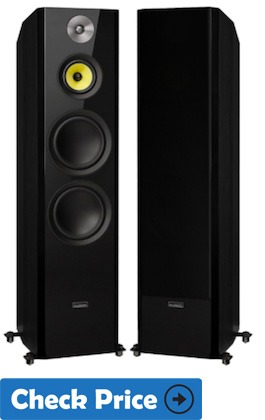 This pair of Fluance floor speakers cost a little more but worth your money, there’s no question about it. But for the average buyer, if it’s $ 699 for a pair, then it still falls directly into the “reasonable” category, especially when you consider sound quality and construction.
This pair of Fluance floor speakers cost a little more but worth your money, there’s no question about it. But for the average buyer, if it’s $ 699 for a pair, then it still falls directly into the “reasonable” category, especially when you consider sound quality and construction.
There is a one-inch neodymium balanced silk tweeter that is cooled by what the company calls ferrofluid. The middle range is covered by a five-inch woven fiberglass cone that sits in its own dedicated chamber inside the cabinet. Finally, the pair of eight-inch subwoofers that deliver a decidedly undistorted sound from 35Hz, which will fit perfectly with the rumble of an action movie.
Now, let’s talk about power; these speakers operate under a sensitivity of 89 dB and have a handling power of 200 watts (although they will be more like 90 watts continuously). They are compatible at the 8-ohm level, which is standard for a home stereo, and Fluance has even designed a rear bass port slightly damped around the edges to carry the correct bass resonance at the rear end without too much ring. Each tower measures 47.24 x 10.9 x 15.4 inches.
- The woofers provide finest lined movement subsequent in a low-frequency bass
- Ultra high-end Neodymium tweeters produce grasping exactness & auditory precision
- distortion-free sound when raising the volume
2. ELAC Debut 2.0 F6.2
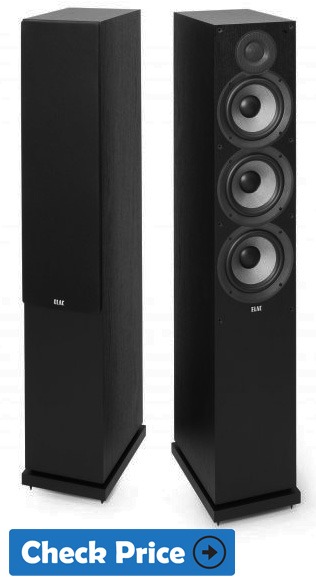 The ELAC Debut 2.0 F6.2 stands out above the rest with a price that is not beyond the reach of the majority and a performance that will make you want to stay listening to music and watching movies every weekend. At 43.2 inches high, the F6.2 offers a one-inch silk dome tweeter and three 6 1/2 inch drivers, the top on which sits a separate camera that offers its own bass port.
The ELAC Debut 2.0 F6.2 stands out above the rest with a price that is not beyond the reach of the majority and a performance that will make you want to stay listening to music and watching movies every weekend. At 43.2 inches high, the F6.2 offers a one-inch silk dome tweeter and three 6 1/2 inch drivers, the top on which sits a separate camera that offers its own bass port.
Renowned speaker designer Andrew Jones did an excellent job of designing this floor speaker with good sound at a price that will make you reconsider buying smaller bookshelf speakers or a soundbar for your entertainment room.
The fiberboard design offers a black vinyl finish, which is not particularly attractive but feels solid and well constructed. A notable addition of a black metal clip on the back that is designed to secure the speaker to a wall to prevent it from tipping over.
When it comes to sound, the F6.2 offers an experience that is well above average. The mid-range and low-frequency dynamics perform admirably, while the bass lines are more than adequate for filling a small room. The F6.2 almost creates a feeling of being in a concert hall for a live performance of the orchestra, which is impressive for its price.
Even so, if you are trying to fill a larger room, you may have to pair the F6.2 with a dedicated subwoofer to increase the bass. We would like to have a little more of the higher harmonics, but for the cost, you can not ask for more from the F6.2.
- Improved dispersion
- It has multi element crossover
- Included floor spikes
- The speakers may not produce strong, deep bass without a subwoofer.
- Their large size can take up significant space, making them less suitable for small rooms.
Bottom Line: The ELAC Debut 2.0 F6.2 speakers deliver excellent clarity and balanced sound, especially in the midrange and treble. While they may lack deep bass and take up more space, they are a great choice for those seeking high-quality audio performance in a larger room, especially when paired with a subwoofer.
3. Onkyo SKF-4800 : Best Budget Floor Speaker
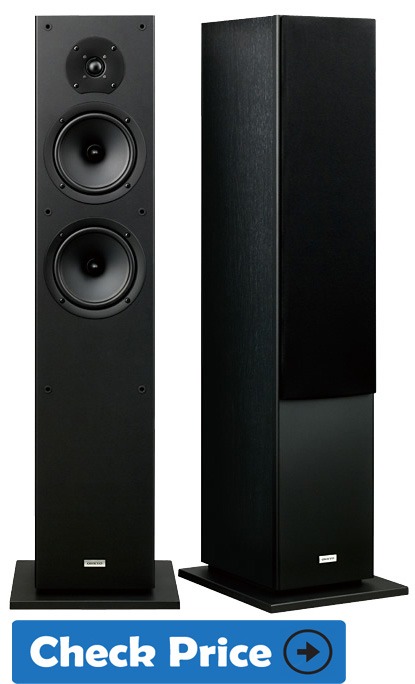 Onkyo SKF-4800 two-way low profile floor speakers reflect a fantastic sound at an economical price. Sold as a pair, speakers 40 inches high, 11.1 inches wide and 12 inches deep can be used to complement an existing stereo system or as the basis for a complete surround sound system. With two 6.3-inch cone woofers and a one-inch soft dome tweeter, the maximum input power of 130W is more than enough to provide an excellent audio experience.
Onkyo SKF-4800 two-way low profile floor speakers reflect a fantastic sound at an economical price. Sold as a pair, speakers 40 inches high, 11.1 inches wide and 12 inches deep can be used to complement an existing stereo system or as the basis for a complete surround sound system. With two 6.3-inch cone woofers and a one-inch soft dome tweeter, the maximum input power of 130W is more than enough to provide an excellent audio experience.
Each Onkyo speaker weighs 28.7 pounds. They feature a rear panel that houses a bass port, and they even have connection ports for banana plugs, pegs or bare wires (such as the 11.5-foot-long speaker cables that are included when coming out of the box). As for the sound quality, it is clean and detailed, without the feeling of heat or overcompensated.
- Affordable Price: Great value for budget-conscious buyers.
- Clear Sound: Delivers crisp and detailed audio.
- Natural Bass: Good low-end response for the price.
- Elegant Design: Simple yet stylish look that fits most rooms.
- Easy Setup: Straightforward installation process.
- Limited Deep Bass: May require a subwoofer for more impactful bass.
- Basic Features: Lacks advanced features found in higher-end models.
4. Emotiva AirMotiv T1
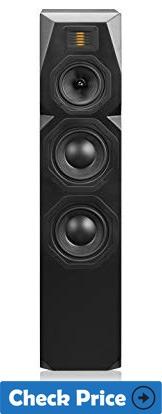 The Emotiva Airmotiv T1 is a large, affordable three-way speaker that includes high-end appointments, including a folded ribbon tweeter. The sound quality that the T1 offers is close to the holiest trinity of sound quality: powerful bass, medium expressive range and aired highs. The bass response is deep enough to forget the need for a separate sub in smaller rooms.
The Emotiva Airmotiv T1 is a large, affordable three-way speaker that includes high-end appointments, including a folded ribbon tweeter. The sound quality that the T1 offers is close to the holiest trinity of sound quality: powerful bass, medium expressive range and aired highs. The bass response is deep enough to forget the need for a separate sub in smaller rooms.
The dynamic sound of the Emotiva Airmotiv T1 will attract audiophiles with a limited budget who crave great sound for music and home theater systems.
The Emotiva Airmotiv T1 produces an open and natural sound for both movies and music, and its compact and innovative cabinet design makes it suitable for any cinema of any size.
These towers were identified as the best by a diverse panel, to reproduce the roaring sounds of low frequency during the chase scenes, which is surprising considering that they compete for side by side with speakers that have 8-inch woofers and a frequency response wider.
The 6-inch woven fiber woofers complement very well with a 5.25-inch media controller that pushes the dialogue against the loud and thunderous effects of the movie listening test. Being able to hear the dialogue about high effects is an important feature for floor speakers, especially if they do not have a center channel speaker.
These speakers, however, have an impedance rating of 4 ohms. That makes them difficult to match with most A / V receivers because most of these that cost less than $ 350 are compatible only with 6 and 8-ohm speakers.
The T1 can handle up to 300 watts of maximum power and 150 watts continuous to 4 ohms. Be sure to pair these speakers with the proper amplification to make sure you do not damage your speakers or the amplifier.
- Exceptional Sound Quality: Delivers rich and detailed audio across all frequencies.
- Wide Dispersion: Offers an expansive soundstage for a more immersive listening experience.
- Solid Build Quality: Sturdy construction ensures durability and longevity.
- Versatile Design: Stylish appearance that complements various home decor.
- Excellent Value: High performance at a competitive price point.
- Size and Weight: Relatively large and heavy, requiring ample space for setup.
- Limited Bass Response: May not produce deep bass without the addition of a subwoofer.
5. JBL Studio 290
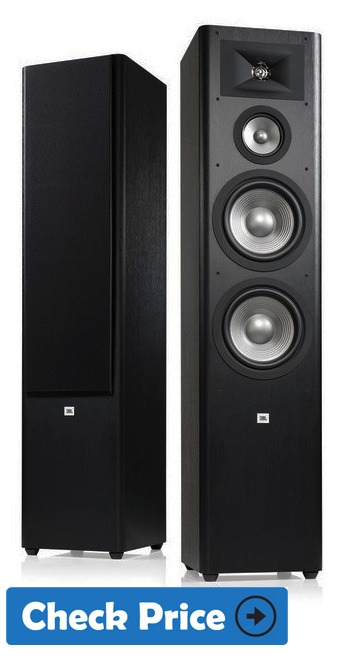 Sound
Sound
When you purchase an audio system, you are interested in being able to interpret the full range of sounds you need to have quality entertainment as you would enjoy it in a professional movie theater, something that you should not worry about with the JBL model. includes a pair of low-frequency sound players with a 200mm PolyPlas cone of 8 "so they can generate doubly powerful bass sounds to offer the most realistic reproduction, providing an attractive experience of what you are listening to, It translates into movies that cause greater effect and music with great fidelity.
Power
So that you do not have to worry about the sound capacity that it can produce, the model offers to generate fidelity up to 91 dB of sound, enough to be heard with power in a large room. On the other hand, the amplifiers can work up to 225 W with an adequate response to frequencies from 38 Hz to 22 kHz so they give you an efficient amplitude.
It also has a nominal impedance of 8 Ohms, so they will provide an adequate performance to have a better sound to meet your needs.
Design
The space that occupies a speaker is important because it will remain in view permanently in your room and when an adequate balance between sound and size is provided, the result is a convenient sound system. Thinking about this, JBL has worked on this product to offer comfortable dimensions of 27.3 x 33 x 119.7 cm for this speaker, so you will have no problem locating it in your living room to enjoy without decreasing your space.
- Powerful Sound: Delivers strong and dynamic audio for an immersive experience.
- Wide Frequency Range: Excellent clarity across lows, mids, and highs.
- Stylish Design: Modern aesthetic that fits well in any home decor.
- Versatile Use: Suitable for both music and home theater setups.
- High Sensitivity: Efficient performance with a variety of amplifiers.
- Bulky Size: Larger footprint may not suit smaller spaces.
- Limited Deep Bass: May require a subwoofer for enhanced low-end performance.
6. Q Acoustics 3050i Best Stereo Speakers
The Q Acoustics 3050i are striking floor standing speakers with dual 165 millimeter (6.5 inches) and 22 millimeters (0.9) inch precision drivers. The 3050i speakers can be mounted on the floor and placed with rubber feet or spikes (included). The 3050i floor-standing speaker is designed using Helmholtz Pressure Equalization (HPE). This significantly improves the linearity of bass performance.
Unique technologies The Q 3050i speakers feature a range of unique technologies, including HPE and P2P, to ensure that these floor standing speakers deliver truly exceptional sound. The HPE (Helmholtz Pressure Equalizer) technology designed to convert pressure into speed and reduce overall pressure in the speaker enclosure is applied to the Q 3050i floor standers to reduce cabinet resonance.
This technology is perfect for speakers that tend to resonate on a favorite frequency.
The Q Acoustics P2P amplification in the 3000i series supports the parts of the enclosure that need to be stiffened, improving the focus of the stereo image and reproducing the sound image more accurately.
High-frequency driver unit The Q 3050i tweeters are disconnected from the baffle via a flexible suspension system. Any vibrations from the woofer that can interfere with the performance of the tweeter are isolated. This makes the tweeter work with greatly reduced interference.
Finishes: All are finished with an attractive chrome edge around each driver and are equipped with magnetic speaker grilles.
- Rich Sound Quality: Delivers a well-balanced and immersive audio experience.
- Stylish Design: Sleek and modern aesthetics complement any room decor.
- Wide Soundstage: Provides excellent imaging and depth in music playback.
- High Sensitivity: Works well with a variety of amplifiers, ensuring efficient performance.
- Versatile Use: Great for both music and home theater applications.
- Requires Space: The larger size may not fit well in compact rooms.
- Limited Bass Without Subwoofer: While good, the bass response may be enhanced with a subwoofer for deep lows.
Bottom Line: The Q Acoustics 3050i speakers are an outstanding choice for those seeking high-quality stereo sound. With their rich audio performance and stylish design, they are perfect for music enthusiasts and home theater setups. While they may require ample space and a subwoofer for optimal bass, their overall sound quality and versatility make them a top contender in their category.
7. Polk Audio T-50: Cheapest Floor Standing Speaker
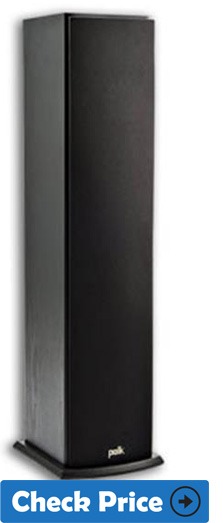 The American brand Polk Audio is specialized in HiFi loudspeakers, which it sells in different ranges, with manufacturing warranty for 5 years.
The American brand Polk Audio is specialized in HiFi loudspeakers, which it sells in different ranges, with manufacturing warranty for 5 years.
The Polk Audio T50 is the perfect low-end speaker for anyone looking to save a few dollars but still, want to build a quality home theater system. Each speaker of the T series of Polk presents good acoustics and the construction gives us a sound quality commensurate with that.
The speaker layout offers four separate cones: a one-inch silk tweeter for scintillating highs, a 6.5-inch "extended-throw" speaker as the main speaker, as well as two additional 6.5-inch composite subwoofers to support the bass.
The cabinet comes in an elegant black oak finish and is built with inert acoustic MDF, for furniture, to make sure that all it does is perfect and project the sound forward. The appearance is further accentuated when you remove the front grille to reveal the configuration of the speakers. Each unit measures 7.75 x 8.75 x 36.25 inches and weighs 20.35 pounds. This is the most affordable thing you can order from a 100-watt, 6-ohm floor speaker.
- Affordable Price: One of the most budget-friendly floor standing speakers available.
- Good Sound Quality: Delivers clear audio with decent bass for the price.
- Attractive Design: Sleek and modern appearance that fits various interiors.
- Versatile Performance: Suitable for music and home theater applications.
- Easy to Set Up: Straightforward installation process for hassle-free use.
- Limited Bass Response: May lack deep bass without a subwoofer.
- Build Quality: Construction feels less premium compared to higher-end models.
8.KEF Q900W Best Floor Standing Tower Speakers
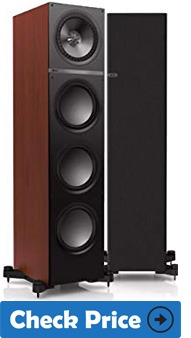 The Q series has been KEF's flagship loudspeaker line for some time. The Uni-Q pilots were first designed in 1988. They have been the subject of improvement and refinement since then. They are really a line of speakers reinvented with better performance than ever.
The Q series has been KEF's flagship loudspeaker line for some time. The Uni-Q pilots were first designed in 1988. They have been the subject of improvement and refinement since then. They are really a line of speakers reinvented with better performance than ever.
The KEF Q series has three components of 8 "8-ohm controllers (one specific subwoofer) and one upper part of Uni-Q driver with a 1.5" tweeter. They are designed with the KEF "Uni-Q" Matrix Controller, which eliminates the traditional 'sweet spot' speaker. The result is a set of tower speakers that are capable of producing a realistic and natural sound.
Aesthetically, the cutting edge of the Q series, like that, but it's not perfect. Built with eco-friendly wood pulp, the material of the cabinets simulate authentic wood very well. They are available in black, oak, European walnut, rosewood, and linear white.
- Exceptional Sound Quality: Delivers detailed and immersive audio across a wide frequency range.
- Uni-Q Driver Array: Innovative design provides a wide soundstage and excellent imaging.
- Sturdy Build: Solid construction enhances durability and reduces cabinet resonance.
- Elegant Design: Sleek and stylish appearance that complements modern interiors.
- Versatile Use: Great for music, movies, and home theater setups.
- Higher Price Point: More expensive than many other floor standing speakers, which may not suit all budgets.
- Large Size: Requires ample space for optimal placement and performance.
Bottom Line: The KEF Q900W speakers are among the best floor standing tower speakers available, offering exceptional audio performance and innovative design features. While they come at a higher price and require more space, their rich sound quality and versatility make them an excellent investment for serious audiophiles and home theater enthusiasts alike.
How to Choose Best Floor Standing Speakers | Buyer’s Guide
You may wonder how to choose the right sound amplifiers. To help you understand a little more about its operation, we will let you know some of the features that you should keep in mind when you go to make your purchase.
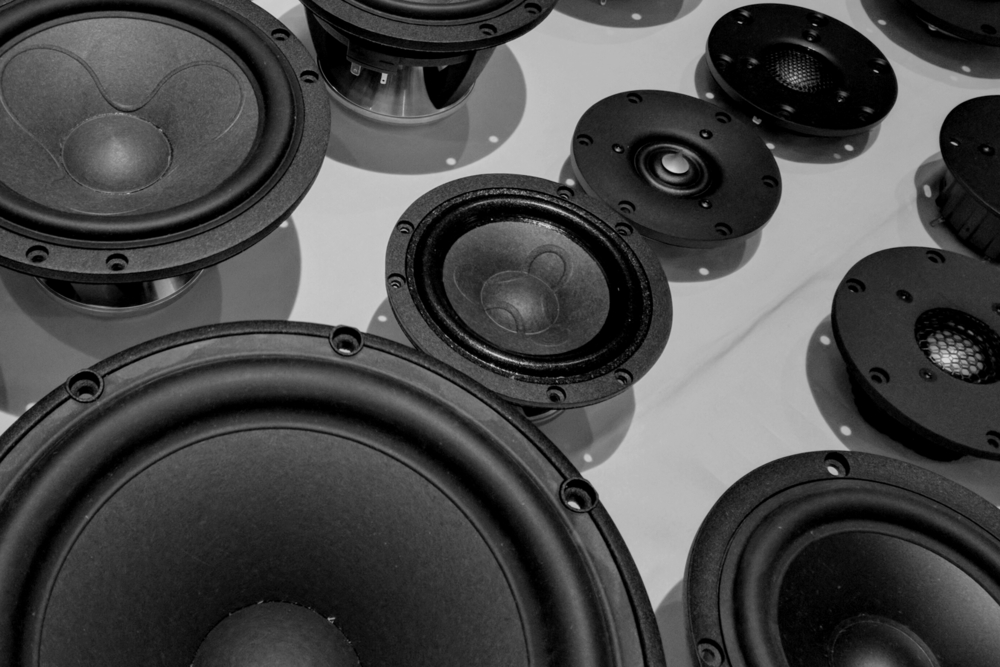 Drivers:
Drivers:
The controllers are the individual speakers that make up the tower speakers. It is important to know what they are and the individual performance of each one. It is the combination of these drivers, and how they complement each other, which makes the overall performance of your tower speakers. Here are some terms that will help you understand the composition of your controllers.
- Speakers: The woofer speaker can determine the responsiveness and the quality of the speaker. The harder and lighter the material used, the louder the speaker. Polypropylene is a very common material used for the cone, as well as fabrics such as Kevlar. Aluminum and titanium, are also used in the top-range speakers.
- Woofer: Surround is also an important aspect of the speaker system and the sound effect. Rugged, lightweight and without moving materials are used to allow the woofer to move with the least amount of energy possible. The material is essential for a long duration and performs loudspeaker too. As speakers age and used, levels of moisture and wear can crack and even break the surroundings of the woofer. Surrounding rubber is usually the longest of a high-performance material. A foam cloth is in the vicinity of less expensive speaker components, with lower performance and a shorter lifespan.
- Crossovers: When you buy a car speaker system component, a crossover is almost always a part of the package. External crossovers are usually used to decrease the amount of distortion, a speaker could have to separate the frequency inputs. The signals can traverse the coated wiring and cause distortion, thus an external handover system limits this.
- The audio has to be heard clearly and forcefully. HiFi loudspeakers or loudspeakers can emit a sound faithful to the original, by which the same characteristics are perceived when creating it because they reduce the noise and alterations that cause the sonorous distortions.
PERFORMANCE:
Hands down the most important thing to consider when floor-standing tower speakers are investigated is the sound quality. Here are some terms that will help you understand performance and how to choose the best one.
- Power handling (Wattage): it is the power measurement of manufacturing given to rate how much power a speaker can handle and operate on. It is given by two measurements, RMS and peak (or MAX). RMS power is the amount of energy the speaker continuously controls, while the nominal power peak is the amount of energy a speaker can handle in short bursts. When comparing the speakers, the RMS Power is a more relevant and important rating to watch.
- Sensitivity: The nominal speaker sensitivity is a measure of the amount of sound the speaker emits since power is given. The greater the sensitivity, the more efficient the speaker will be with the power is given. For lower feed systems, you want a higher rating sensitivity. For a higher power system, you want a lower rating sensitivity. Lower nominal sensitivity of the speakers is designed to handle greater power.
- Frequency range: frequency range is the frequencies that the speaker emits sounds, measured in Hz. Normally it goes from low to high frequency, for example, 20 - 22,000 Hz (22k). This measure how low and high the speaker can actually emit sounds in.
Design:
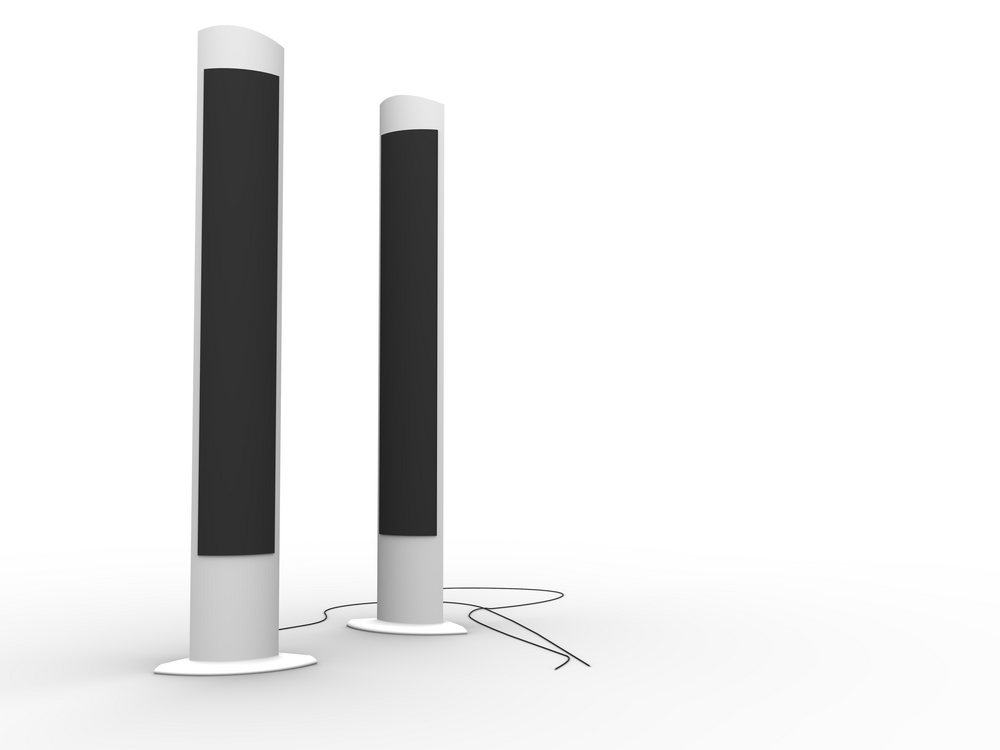 Another important element to take into account when investigating the tower speakers is the design. Size, housing, housing material, color - all are important! Smaller and lighter speakers are ideal for mounting in small spaces but can impair the frequency range and sound quality.
Another important element to take into account when investigating the tower speakers is the design. Size, housing, housing material, color - all are important! Smaller and lighter speakers are ideal for mounting in small spaces but can impair the frequency range and sound quality.
The type of housing and/or workstations that are also important: you can choose between terminals or box boxes, depending on your preferences and limitations of space that is placing the speakers.
Connection terminals usually give more space and wiring options, although sometimes Fuller box boxes, give you better sound quality. Then, of course, there is no color. Some speaker models are limited by color, and may not match the style of your home.
Floorstanding vs Bookshelf Speakers
The difference between these two kinds of speaker is understandable. The Floor-standing speakers are thin & tall while the bookshelf speaker and plump & short.
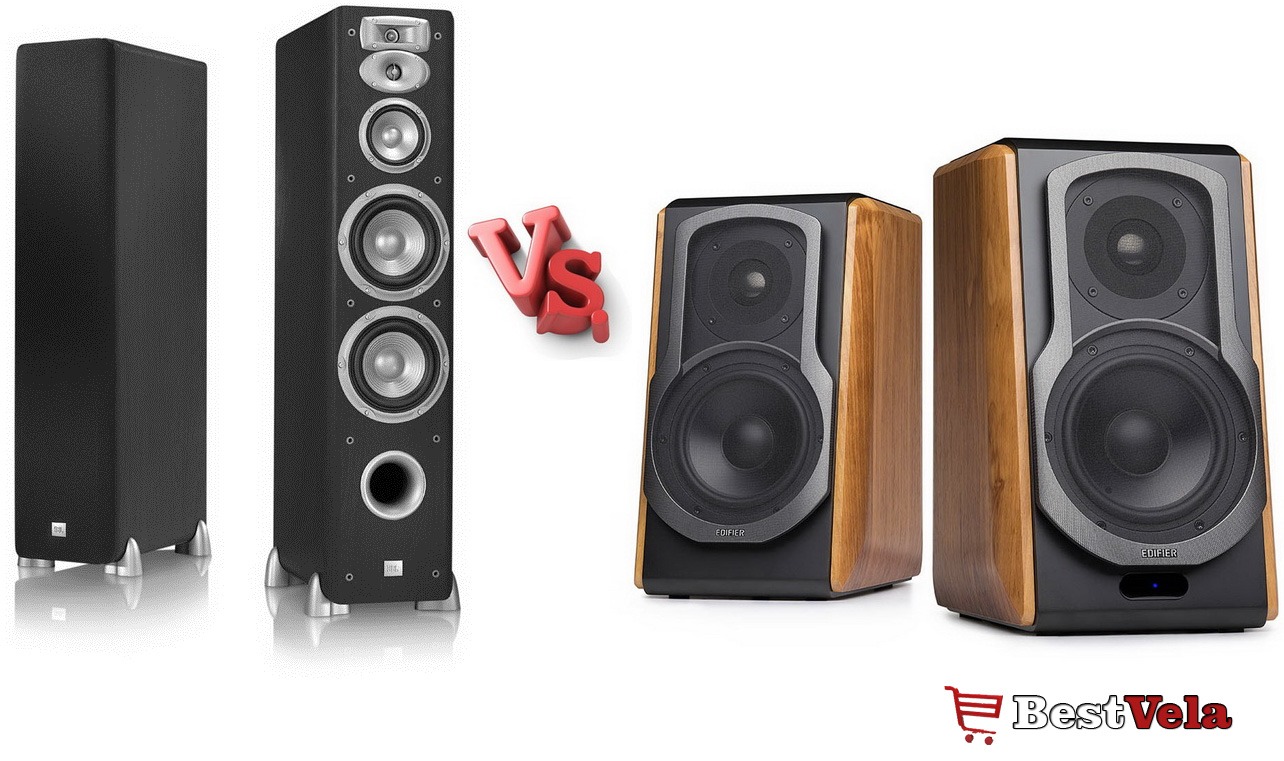
Bookshelf Speakers
This type of loudspeaker is a cheaper alternative than the floor and also occupying less space. They can be considered as small brothers of the floor, and require a shelf or support where they put. Most of these speakers have only two speakers, usually one of them (the smallest) for treble. Although its quality is not as good as that of the soil, yes we will be getting good quality with them.
For these speakers it is advisable to equip a subwoofer that complements the sound range, being able to have a 2.1 of good quality. In addition, they are very flexible and allow combinations with other speakers or subwoofers if we have a suitable amplifier.
These types of speakers are larger than those included in a speaker system and are mainly used in high-fidelity sound systems, such as stereo systems. They are usually placed in furniture (hence their denomination) and used in stereo configurations (without a subwoofer). They handle a wide range of frequencies.
Floor Speakers
These speakers, as their name suggests, are designed to be placed directly on the floor. They are also known as stand-up speakers, and in them, there are usually several speakers and one or more tweeters that are responsible for the treble. If you add a subwoofer to that, you have a great coverage of all the ranges of sounds: high, medium and low.
Where most often these speakers are seen is in home theater equipment, and probably the best option you can choose to watch movies, series or listen to music
Hi-Fi vs Home Theater Speaker
 HiFi System (HiFi equipment)
HiFi System (HiFi equipment)
Hi-Fi systems are made for the reproduction of music in stereo sound (2.0) or, put another way, in a format with two audio channels. Almost all the music of the world is made under these parameters since it is easier to record than other types of multichannel tracks. It is for this reason that when you hear music with headphones, both seem to play different sounds, and the same principle applies to these devices.
The HiFi sound systems usually bring two large loudspeakers in the form of panels - one left and one right - that generate an excellent audio broadcast. For a better experience, column loudspeakers are often preferred over compact loudspeakers, since they have a dedicated frequency range (low, medium or high frequency), which makes it possible to obtain a sound that is more faithful to the quality of the source.
In effect, this type of player is designed for music lovers, who seek to get as close as possible to the version originally recorded to better appreciate the instruments, mixes and audio transitions.
Home Theater System
The first distinction that can be appreciated is its size: a Home Theater, unlike HiFi, is much larger because it requires more speakers and is aimed at reproducing videos to recreate the concept of "home cinema".
For this reason, audiovisual content requires another form of audio tracks in relation to HiFi equipment. For the specific sound of the film, series or recital to materialize, it is necessary to have a multichannel system capable of reproducing, for example, the ambient sound, the music, the voice of the protagonists and sound effects such as thunder or general laughter.
This large spectrum of sound is possible since a Home Theater makes use of a greater number of speakers. Most of these devices have the 5.1 surround sound configuration, that is, 5 speakers that surround the room producing a full frequency range, and 1 low-frequency subwoofer to make sure that the bass resounds when a vehicle explodes on the screen.
Which to choose: Home Theater Or HiFi?
The answer is in another question: do you spend more afternoons enjoying movies or relaxing with the sound produced by your favorite musicians? In the first case it is better than you choose a Home Theater and in the second a HiFi system. Both mean investment and also a physical space, so acquiring and using each one with an appropriate purpose will make the reproduction quality of the sound what you were looking for.
3-Way VS 2-Ways Floor Standing Speakers
3-Way Speakers
3-way simply refers to the selection of drivers that a speaker uses to produce sound. The 3-way configuration incorporates a baffle for low frequencies, a tweeter for high frequencies and a mid-range driver. Each speaker has at least 3 separate drivers to produce a variety of frequencies. The 3-way design is very common among the speakers and is used by many manufacturers.
Two-Way Speakers
Two-way speakers dispersed the frequencies they produce into lows and highs. It uses a woofer (for lows) and tweeter (for highs).
How to connect and place Floor Standing Speakers?
The golden rule is that you should not connect speakers to a computer without rhyme or reason. You have to read the instructions and in case of doubt consult specialized people because an error can mean, at least, that the equipment does not sound or does not work correctly, and in the worst case, the serious system failure.
To connect passive speakers to an amplifier, one must take into account, and in this order, the impedance and power.
Most amplifiers have a minimum output impedance of 4 or 8ohms. Therefore, loudspeakers with a lower impedance should never be connected to those required by the amplifier for the reasons explained above. If we connect speakers with higher impedance there is no danger.
In the case of connecting more than one speaker per channel of the amplifier, knowing how to do the impedance calculations is vital.
So as not to become too saturated, I'll explain briefly.
Connection in series; the impedances of the loudspeakers are added.
Connection in parallel: the impedances are divided. You have to keep in mind that, if all the speakers have the same impedance, the way to calculate is to divide the impedance of a speaker among the number of speakers that you will connect in each channel. If the speakers are of different impedances, the calculation is made by multiplying the impedances of all connected speakers and dividing the result by the sum resulting from the sum of them. (that is, product divided by sum).
Tell you that there are also combinations of serial-parallel connections, to connect a high number of speakers.
Typical connection example
4 speakers of 4 ohms each. You have to connect them to a stereo amplifier with a minimum output impedance of 8 ohms. If you connect two speakers in series for each of the two amplifier channels, you will have the required 8 ohms, adding 4 + 4 to each output.
Conversely, if you connect them in parallel, the resulting impedance will be 2ohms per channel. Result; burned amplifier.
As for the power, if you connect a 100-watt speaker to an amplifier that only gives you 5w output, it will not sound to you because the amplifier cannot do it with them, if you do it the other way around, (very low-powered speakers with an amplifier of 100 w of output, for example) as soon as you raise the volume a little, you will break the speakers due to excessive power. It is important in this case to buy balanced speakers with the power of the amplifier.
When making the connections, it is vital to also identify the positive and negative poles of the amplifier and the speakers and match them, usually the positive is usually red and the negative black, in the connection cables it is also signaled, as, in the case of crossing them, the bass speakers will not sound.
Regarding the placement of the speakers, to enjoy an optimal listening should be placed at the height of our ears to not lose detail, especially high or high frequencies, which are very directional. In case of having to place them in a higher place, due to lack of space, it is recommended to do so with a slight inclination towards the place where we are going to place ourselves for listening.
Best Floor Standing Speakers FAQs
How to connect floor standing speakers to the PC?
The process of connecting HiFi speakers to your PC is not as simple as connecting simple speakers designed for the computer. Among other things, because we are going to need additional elements to make those connections and that everything works as it should. Among these complements, the amplifier must not be absent.
And it is that the power of the signal that emits the sound card of our computer is very reduced, the reason why if we do not use an amplifier that is able to increase the intensity of the same surely we do not listen to anything. This amplifier should have a power similar to that of the speakers that we are installing so that it is not so small as to maintain the problem of not generating power nor so high as to emit at a much higher power than our speakers, which could end up damaging them.
This amplifier must be connected between the speakers and the PC, in order to obtain good listening results, according to the connection instructions of the device. And, in any case, do not forget to verify that the rest of the technical parameters, both the amplifier and the connectors, are adequate to avoid damaging them prematurely.
How to place floor standing speakers?
There are some small precautions regarding the proper placement of HiFi speakers. Among these precautions, we should avoid sticking the speakers in excess to the wall, except in case they have a reduced power. In this case, the fact of leaving them glued to the wall can help us to intensify in part the power of the sound. It is also convenient that the speakers have a proper orientation, forming a line that converges where we are going to place to listen to the sound.
Finally, the speakers must be placed on quality supports and we must ensure that they do not move or move during use. Something that not only affects the quality of the sound but can also cause some fall of the speaker in case the vibrations are moving along the surface on which it rests.
How to connect floor standing speakers to the TV?
As with other devices, the process of connecting HiFi speakers to our TV requires certain extras during the process. Among them, we find the amplifier, which will be necessary so that the intensity and strength of the signal are sufficient for it to be reproduced adequately on our television.
That power should be similar to the sum of the loudspeakers, so we do not fall short or exceed it. It is also necessary to verify the type of existing connections, given that they are probably not compatible with the television and we have to make some changes to the collectors. Anyway, if the speakers are connected to a stereo or a mini-stereo and it has an audio input, the process is much simpler. It would be enough to connect the audio input of the mini-system with the audio output of the TV to enjoy the sound through the speakers.
What is better to use, HiFi speakers or monitors?
Although its name points more to the image than sound, monitors are a type of speaker used in recording studios. In fact, they are generally referred to as study monitors for this reason. Something that guides us towards the level of quality that we are going to achieve with this particular type of speaker. This is precisely the reason that will lead us to choose one model or another.
And is that studio monitors require audio sources of the highest quality since they amplify all the good of a piece of music, but also the possible defects of it. Therefore, they are of little use if the source of sound is a cheap micro-chain. A quality that, as was also expected, has a price much higher compared to what a conventional HiFi speaker costs. Therefore, unless you have this quality sound source and the money that the product costs, in general, conventional HiFi speakers will be more advisable than studio monitors.
How do I use floor standing speakers?
The red and black connections are for speaker wire, and there will be matching red and black connectors on the back of the amplifier. Simply hook the speaker wire into the amplifier/receiver.
Is my room too small for floor standing speakers?
If your room size is 10 feet x 10 feet or bigger, then floor standing speakers will be ideal.
How to repair a floor-standing speaker?
HiFi speakers are high-tech devices whose repair is not available to anyone. In fact, there are few elements that we can repair ourselves in a HiFi speaker even having the necessary knowledge for it. Among these elements is the fuse, in case the speaker includes it, that we can replace in case it is founded for any reason.
We can also make small repairs on the wiring in case the connections are damaged or do not generate the signal properly. Another basic repair that we can make, if we know how to do it, is to make a small patch in the cone in case there has been a small crack or perforation of it. For this, we will carefully access the area where the hole is located and we will place some insulation tape or similar in the damaged area to solve this problem.
And in the case of the handiest, there are kits with which you can replace some other internal parts of the speaker. However, we are already talking about arrangements that require advanced knowledge, which often only have those who really dedicate themselves professionally to repair speakers.
Conclusion: Best Floor Standing Speakers Under $1000
Investing in quality floor standing speakers can significantly enhance your audio experience, whether for music, movies, or gaming. With a budget of under $1000, you have access to a variety of excellent options that deliver impressive sound performance, aesthetics, and durability.
The speakers we've discussed in this guide offer exceptional value, featuring advanced technology and design elements that ensure clear highs, rich mids, and deep bass. Consider your specific needs, such as room size, aesthetic preferences, and intended use, when making your choice.
Ultimately, the best floor standing speakers under $1000 will elevate your sound system, providing an immersive listening experience that enriches your daily entertainment. Choose wisely, and enjoy the transformative power of high-quality audio in your home!
Top Rated Floor Standing Speakers 2025






